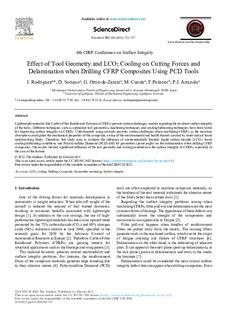Izenburua
Effect of Tool Geometry and LCO2 Cooling on Cutting Forces and Delamination when Drilling CFRP Composites Using PCD ToolsEgilea
Egilea (beste erakunde batekoa)
Beste instituzio
University of LjubljanaBertsioa
Bertsio argitaratua
Eskubideak
© 2022 The AuthorsSarbidea
Sarbide irekiaArgitaratzailearen bertsioa
https://doi.org/10.1016/j.procir.2022.03.116Non argitaratua
Procedia CIRP. Vol. 108. Issue CLehenengo orria
752Azken orria
757Argitaratzailea
ElsevierGako-hitzak
LCO2 cooling
Drilling
composite
Sustainable machining ... [+]
Drilling
composite
Sustainable machining ... [+]
LCO2 cooling
Drilling
composite
Sustainable machining
Surface integrity [-]
Drilling
composite
Sustainable machining
Surface integrity [-]
Laburpena
Lightweight materials like Carbon Fiber Reinforced Polymers (CFRPs) present certain challenges, mainly regarding the resultant surface integrity of the holes. Different techniques such as optimized to ... [+]
Lightweight materials like Carbon Fiber Reinforced Polymers (CFRPs) present certain challenges, mainly regarding the resultant surface integrity of the holes. Different techniques such as optimized tool geometries, machining techniques and cooling/lubricating techniques have been tested for improving surface integrity on CFRPs. Unfortunately using coolants presents certain challenges when machining CFRPs, as the moisture absorption can degrade the mechanical properties of the composite, on top of the environmental and health hazards created by water and oil based metalworking fluids. Therefore, this study aims to evaluate the influence of environmentally friendly liquid carbon dioxide (LCO2) based cooling/lubricating conditions and Polycrystalline Diamond (PCD) drill bit geometries (point angle) on the delamination when drilling CFRP composites. The results showed significant influence of the tool geometry and cooling condition on the surface integrity of CFRPs, especially in the case of the former. [-]
Bildumak
Item honek honako baimen-fitxategi hauek dauzka asoziatuta:






















